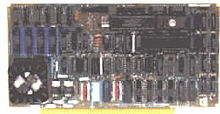- OCTART 8 channel Communications Processor
-
Contents
Background
In the earliest days for Cromemco a computer might run a single user single tasking Operating System like Cromemco CDOS. Here one would need at a minimum a single serial port interface to connect an ASCII terminal to a Cromemco computer.
Since it was necessary to have a Cromemco floppy disk controller to use CDOS, and since these disk controllers had an on card serial port such a system would have no need of an Octart style board.
Also recall at that time (1980 or thereabouts) printers would usually be of Centronics parallel interface and therefore connected using the Cromemco PRI or equivalent card.
However, the introduction of Cromemco Cromix even in its initial Z80 processor form brought multi-tasking and multi-user.
Multiple users would each have need of an ASCII termainal and a serial connection to the Cromix driven Cromemco computer.
The base level solution to provide addition serial ports would be to use the Cromemco TUART card.
Later this would have been a Cromemco QUADART and IOP series of cards.
Then in the latest generation it was to use a Cromemco OCTART.
Introduction
The Octart board was Cromemco's second-generation, co-processing subsystem which interfaced eight serial channels and a bi-directional parallel port to a host S-100/IEEE-696 bus. A typical Octart application might consist of interfacing eight computer terminals to the host system.
Unlike earlier serial interface boards, which merely formatted and exchanged individual data characters, the Octart featured a sophisticated DUART communications circuit plus an independent Z80A processor with 64K bytes of memory. This enabled the Octart to:
- Perform all protocol and error-detection/recovery functions.
- Buffer large amounts of serial data.
- Pass only preprocessed data over the host bus using
interrupt-driven I/O.
This reduced the processing load on the host CPU and dramatically increased system throughput.
The Octart was a versatile serial subsystem. Under program control, it could switch its internal memory configuration from 16K bytes of ROM and 32K bytes of RAM to a full 64K bytes of RAM.
Thus the board can include a ROM bootstrap program which loads an application program, and then switches to 64K bytes of RAM for maximum buffer space. The eight serial channels could operate independently of one another in any of four modes: full duplex, auto echo, local loopback, and remote loopback.
Each channel can be programmed to automatic wake-up mode for multidrop applications.
Software levels
The Octart required Z80 Cromix version 11.24 or later, or 68000 Cromix 20.61 or later
See also
To learn much more, see the Cromemco Octart Asynchronous Communications Processor Instruction Manual. This includes not only more details on setup switch settings but also a full Z80 listing of the Octart Monitor which is the assembler program held on the 27128 16KB PROM which forms the software heart of this card.
Categories:- Serial buses
Wikimedia Foundation. 2010.

